

Enoxaparin sodium Ledraxen

Ask a doctor about a prescription for Enoxaparin sodium Ledraxen

How to use Enoxaparin sodium Ledraxen
PATIENT INFORMATION LEAFLETEnclosed patient information leaflet
Enoxaparin sodium Ledraxen, 2000 IU (20 mg)/0.2 mL, solution for injection in a pre-filled syringe
Enoxaparin sodium Ledraxen, 4000 IU (40 mg)/0.4 mL, solution for injection in a pre-filled syringe
Enoxaparin sodium Ledraxen, 6000 IU (60 mg)/0.6 mL, solution for injection in a pre-filled syringe
Enoxaparin sodium Ledraxen, 8000 IU (80 mg)/0.8 mL, solution for injection in a pre-filled syringe
Enoxaparin sodium Ledraxen, 10,000 IU (100 mg)/1 mL, solution for injection in a pre-filled syringe
Enoxaparin sodium
This medicinal product is subject to additional monitoring. This will allow quick identification of new safety information. You can help by reporting any side effects you may get. See section 4 for how to report side effects.
Read all of this leaflet carefully before using this medicine because it contains important information for you.
- You should keep this leaflet. You may need to read it again.
- If you have any further questions, ask your doctor, pharmacist, or nurse.
- This medicine has been prescribed for you only. Do not pass it on to others. It may harm them, even if their signs of illness are the same as yours.
- If you get any side effects, talk to your doctor, pharmacist, or nurse. This includes any possible side effects not listed in this leaflet. See section 4.
Contents of the pack
- 1. What Enoxaparin sodium Ledraxen is and what it is used for
- 2. Important information before using Enoxaparin sodium Ledraxen
- 3. How to use Enoxaparin sodium Ledraxen
- 4. Possible side effects
- 5. How to store Enoxaparin sodium Ledraxen
- 6. Contents of the pack and other information
1. What Enoxaparin sodium Ledraxen is and what it is used for
Enoxaparin sodium Ledraxen contains the active substance enoxaparin sodium. It belongs to a group of medicines called low molecular weight heparins or LMWHs.
Enoxaparin sodium Ledraxen works in two ways:
- 1) It prevents the formation of new blood clots and stops existing blood clots from getting bigger. This helps your body to dissolve existing blood clots and prevents them from causing harm.
- 2) It prevents the formation of new blood clots in your blood.
Enoxaparin sodium Ledraxen can be used to:
- Treat blood clots that are already formed in your blood.
- Prevent blood clots from forming in your blood in the following situations: before and after surgery, when you are bedridden due to a short-term illness.
in patients who have developed blood clots in the circulating blood due to cancer, to further prevent the formation of new blood clots
- Prevent blood clots from forming in unstable angina (when not enough blood is being supplied to the heart muscle) or after a heart attack.
- Prevent blood clots from forming in the tubes of a dialyzer (used in people with severe kidney problems).
2. Important information before using Enoxaparin sodium Ledraxen
Do not use Enoxaparin sodium Ledraxen if:
- you are allergic to enoxaparin sodium or any of the other ingredients of this medicine (listed in section 6) or to heparin or other low molecular weight heparins such as nadroparin, tinzaparin, or dalteparin. Symptoms of an allergic reaction may include rash, difficulty breathing or swallowing, swelling of the face, lips, tongue, mouth, throat, or eyes.
- you have had a previous reaction to heparin that caused a significant decrease in the number of blood cells responsible for blood clotting (platelets) in the last 100 days.
- you have antibodies against enoxaparin in your blood.
- you have severe bleeding or a medical condition that increases the risk of bleeding, such as stomach ulcers, recent brain or eye surgery, or recent hemorrhagic stroke.
- you are using Enoxaparin sodium Ledraxen to treat blood clots and you are scheduled to have a lumbar puncture or surgery under spinal or epidural anesthesia within the next 24 hours.
Warnings and precautions
Enoxaparin sodium Ledraxen should not be used interchangeably with other low molecular weight heparins. This is because they are not identical and differ in their activity and instructions for use.
Before starting treatment with Enoxaparin sodium Ledraxen, you should discuss with your doctor or pharmacist if:
- you have ever had a reaction to heparin that caused a significant decrease in the number of blood cells responsible for blood clotting (platelets)
- you have a heart valve replacement
- you have endocarditis (infection of the membrane lining the heart)
- you have a history of stomach ulcers
- you have recently had a stroke
- you have high blood pressure
- you have diabetes or have vascular problems in the eyes caused by diabetes (diabetic retinopathy)
- you have recently had eye or brain surgery
- you are elderly (over 65 years), especially if you are over 75 years old
- you have kidney problems
- you have liver problems
- you are underweight or overweight
- you have high levels of potassium in your blood (which can be checked with a blood test)
- you are currently taking medications that may cause bleeding (see section 2 "Enoxaparin sodium Ledraxen and other medicines").
- you have spinal problems or have had spinal surgery.
If any of the above situations apply to you or if you are in doubt, you should discuss this with your doctor or pharmacist before starting treatment with Enoxaparin sodium Ledraxen.
This medicine contains less than 1 mmol (23 mg) of sodium per dose, which is essentially "sodium-free".
Tests and monitoring
Before starting treatment with this medicine and periodically during treatment, you may have blood tests to check the number of platelets in your blood and the level of potassium in your blood.
Use in children and adolescents
The safety and efficacy of Enoxaparin sodium Ledraxen in children and adolescents have not been established.
Enoxaparin sodium Ledraxen and other medicines
Tell your doctor or pharmacist about all the medicines you are taking, have recently taken, or might take.
- warfarin - a medicine used to thin the blood
- aspirin (also known as acetylsalicylic acid or ASA), clopidogrel, or other medicines used to prevent blood clots (see section 3 "Switching anticoagulant therapy")
- dextran injections - used as a blood substitute
- ibuprofen, diclofenac, ketorolac, or other non-steroidal anti-inflammatory medicines used to treat pain and swelling in arthritis and other conditions
- prednisolone, dexamethasone, or other medicines used to treat asthma, rheumatoid arthritis, and other conditions
- potassium-sparing medicines, such as potassium salts, diuretics, or certain heart medicines.
Surgery and anesthesia
If you are scheduled to have a lumbar puncture or surgery under spinal or epidural anesthesia, you should inform your doctor that you are using Enoxaparin sodium Ledraxen.
Pregnancy and breastfeeding
If you are pregnant or breastfeeding, think you may be pregnant, or are planning to have a baby, ask your doctor or pharmacist for advice before using this medicine.
In pregnant women with mechanical heart valves, there may be an increased risk of blood clots. Your doctor should discuss this with you.
Women who are breastfeeding or plan to breastfeed should consult their doctor before starting treatment with this medicine.
Use in children and adolescents
The safety and efficacy of Enoxaparin sodium Ledraxen in children and adolescents have not been established.
Driving and using machines
Enoxaparin sodium Ledraxen does not affect the ability to drive or use machines.
Your doctor should document the trade name and batch number of the medicinal product used.
3. How to use Enoxaparin sodium Ledraxen
This medicine should always be used under the guidance of a doctor or pharmacist. If you are in doubt, you should consult your doctor or pharmacist.
Administration of the medicine
- Enoxaparin sodium Ledraxen will usually be administered to you by a doctor or nurse. This is because it requires injection.
- Enoxaparin sodium Ledraxen is usually administered by subcutaneous injection.
- Enoxaparin sodium Ledraxen may be administered by intravenous injection in certain types of heart attack or after surgery.
- Enoxaparin sodium Ledraxen may be introduced into the dialysis tube returning blood from the body (into the so-called arterial line) at the start of the dialysis session.
- Enoxaparin sodium Ledraxen must not be administered by intramuscular injection.
Dose of the medicine
- Your doctor will decide what dose of Enoxaparin sodium Ledraxen you should receive. This will depend on the reason for your treatment.
- In patients with kidney problems, you may receive a lower dose of Enoxaparin sodium Ledraxen.
- 1) Treatment of blood clots in your blood
- The usual dose is 150 IU (1.5 mg) per kilogram of body weight once daily or 100 IU (1 mg) per kilogram of body weight twice daily.
- Your doctor will decide how long you should receive Enoxaparin sodium Ledraxen.
- 2) Prevention of blood clots in your blood during surgery or when you are bedridden due to illness
- The dose depends on your risk of developing a blood clot. You will usually receive Enoxaparin sodium Ledraxen at a dose of 2000 IU (20 mg) or 4000 IU (40 mg) once daily.
- The first injection is usually given 2 hours or 12 hours before surgery.
- If you are bedridden due to illness, you will usually receive Enoxaparin sodium Ledraxen at a dose of 4000 IU (40 mg) once daily.
- Your doctor will decide how long you should receive Enoxaparin sodium Ledraxen.
- 3) Prevention of blood clots in patients with unstable angina or after a heart attackEnoxaparin sodium Ledraxen can be used in two different types of heart attack. The dose of Enoxaparin sodium Ledraxen will depend on your age and the type of heart attack you have had.
Non-ST-segment elevation myocardial infarction (NSTEMI):
- The usual dose is 100 IU (1 mg) per kilogram of body weight every 12 hours.
- Your doctor will usually recommend that you also take aspirin (acetylsalicylic acid).
- Your doctor will decide how long you should receive Enoxaparin sodium Ledraxen. ST-segment elevation myocardial infarction (STEMI) in patients under 75 years of age:
- The initial dose of Enoxaparin sodium Ledraxen is 3000 IU (30 mg) given as an intravenous injection.
- At the same time, Enoxaparin sodium Ledraxen will also be given as a subcutaneous injection. The usual dose is 100 IU (1 mg) per kilogram of body weight every 12 hours.
- Your doctor will usually recommend that you also take aspirin (acetylsalicylic acid).
- Your doctor will decide how long you should receive Enoxaparin sodium Ledraxen. ST-segment elevation myocardial infarction (STEMI) in patients 75 years of age or older:
- The usual dose is 75 IU (0.75 mg) per kilogram of body weight every 12 hours.
- The maximum dose of Enoxaparin sodium Ledraxen in the first two doses is 7500 IU (75 mg).
- Your doctor will decide how long you should receive Enoxaparin sodium Ledraxen.
Patient undergoing percutaneous coronary intervention (PCI):
Depending on when the last dose of Enoxaparin sodium Ledraxen was given, your doctor may decide to give an additional dose of Enoxaparin sodium Ledraxen before the PCI procedure. This will be given as an intravenous injection.
- 4) Prevention of blood clots in the tubes of a dialyzer
- The usual dose is 100 IU (1 mg) per kilogram of body weight.
- Enoxaparin sodium Ledraxen is injected into the tube returning blood from the body (into the so-called arterial line) at the start of the dialysis session. This dose is usually sufficient for a 4-hour dialysis session. However, your doctor may give you an additional dose of 50 IU to 100 IU (0.5 to 1 mg) per kilogram of body weight if necessary. Self-administration of Enoxaparin sodium Ledraxen. If you are able to administer Enoxaparin sodium Ledraxen to yourself, your doctor or nurse will show you how to do it. Do not attempt to inject yourself if you have not been trained. If you are in doubt, you should consult your doctor or nurse. Injecting the medicine correctly under the skin (subcutaneously) can reduce pain and bruising at the injection site. Before self-administering Enoxaparin sodium Ledraxen
- Prepare all the necessary items: syringe, alcohol swab, soap, and water, and a container for medical waste.
- Check the expiration date on the packaging. Do not use the medicine after the expiration date.
- Check if the syringe is damaged and if the liquid is clear. If not, use another syringe.
- Make sure you know what dose you should inject.
- Examine your abdomen to check if the last injection caused redness, discoloration, swelling, discharge, or if it is still painful. If so, consult your doctor or nurse.
Instructions for syringes without a safety system
- Preparing the injection site: Before injecting, wash your hands and dry them. Use a swab to clean (without rubbing) the chosen injection site. A different area of the abdomen should be used for each injection.
- Remove the protective cap from the needle. It is possible that a drop may appear at the tip of the needle. If this happens, remove the drop by tapping the syringe (with the needle facing down) before injecting.
- Inject the medicine: The pre-filled syringe is ready for immediate use. Choose a site on the right or left side of the abdomen. It should be at least 5 cm away from the navel and towards the side. Hold the syringe so that the needle is facing down (at a 90-degree angle), into the thickness of the skin fold created by pinching the skin between the thumb and index finger of the operator. The fold should be held throughout the injection.
- Dispose of the syringe immediately in a suitable container.
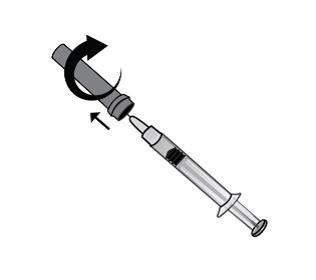
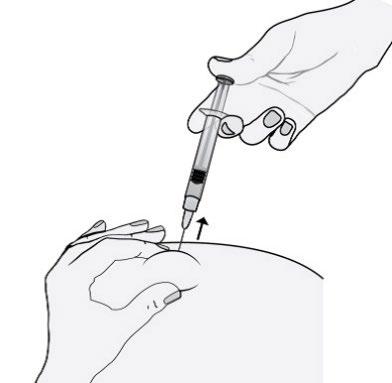
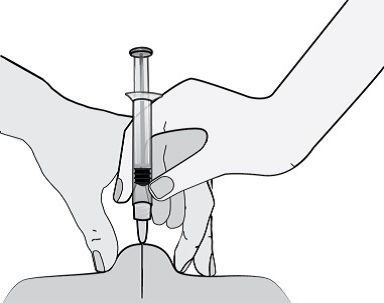
Any unused medicinal product or waste material should be disposed of in accordance with local regulations.
Instructions for syringes with a safety system
- Preparing the injection site: Before injecting, wash your hands and dry them. Use a swab to clean (without rubbing) the chosen injection site. A different area of the abdomen should be used for each injection.
- First, bend the guard to the side by about 90 degrees. Note: Do not remove the cap before bending the guard.
- Remove the protective cap from the needle. It is possible that a drop may appear at the tip of the needle. If this happens, remove the drop by tapping the pre-filled syringe (with the needle facing down) before injecting.
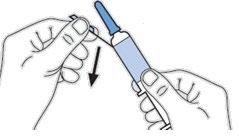
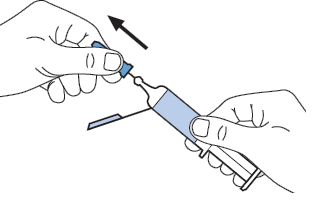
- Inject the medicine: The pre-filled syringe is ready for immediate use. Choose a site on the right or left side of the abdomen. It should be at least 5 cm away from the navel and towards the side. Hold the syringe so that the needle is facing down (at a 90-degree angle), into the thickness of the skin fold created by pinching the skin between the thumb and index finger of the operator. The fold should be held throughout the injection.
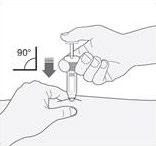
- Secure the needle guard: Using one hand, place the guard on a hard, stable surface. Important: Do not use your finger to secure the needle in the guard. Then press the guard. Bend the guard until the needle clicks into the plastic part.


- Dispose of the syringe immediately in a suitable container.
After injection
- 1) To avoid bruising, do not rub the injection site after injecting.
- 2) Dispose of the used syringe in a container for medical waste. Close the container and store it out of sight and reach of children. If the container is full, dispose of it according to the doctor's or pharmacist's instructions.
Any unused medicinal product or waste material should be disposed of in accordance with local regulations.
Switching anticoagulant therapy
- Switching from Enoxaparin sodium Ledraxen to medicines that thin the blood, known as vitamin K antagonists (such as warfarin)Your doctor will recommend that you have blood tests to check your INR and will tell you when to stop taking Enoxaparin sodium Ledraxen.
- Switching from medicines that thin the blood, known as vitamin K antagonists (such as warfarin) to Enoxaparin sodium LedraxenYou should stop taking the vitamin K antagonist. Your doctor will recommend that you have blood tests to check your INR and will tell you when to start taking Enoxaparin sodium Ledraxen.
- Switching from Enoxaparin sodium Ledraxen to direct oral anticoagulantsYou should stop taking Enoxaparin sodium Ledraxen. Then, you should start taking the direct oral anticoagulant 0 to 2 hours before the scheduled time of the next injection; and then continue taking the medicine as usual.
- Switching from direct oral anticoagulant therapy to Enoxaparin sodium LedraxenYou should stop taking the direct oral anticoagulant. Treatment with Enoxaparin sodium Ledraxen can be started 12 hours after the last dose of the direct oral anticoagulant.
Overdose of Enoxaparin sodium Ledraxen
If you think you have used too much or too little Enoxaparin sodium Ledraxen, you should immediately inform your doctor, pharmacist, or nurse, even if you do not notice any signs of an overdose. If a child has accidentally injected or ingested Enoxaparin sodium Ledraxen, you should immediately go to the hospital emergency department.
Missed dose of Enoxaparin sodium Ledraxen
If you miss a dose of the medicine, you should take it as soon as possible. Do not take a double dose to make up for a missed dose. Keeping a diary can help you remember to take your doses.
Stopping treatment with Enoxaparin sodium Ledraxen
It is important to continue injecting Enoxaparin sodium Ledraxen until your doctor tells you to stop. If you stop treatment, you may develop a blood clot, which can be very dangerous.
If you have any further questions about the use of this medicine, you should ask your doctor, pharmacist, or nurse.
4. Possible side effects
Like all medicines, this medicine can cause side effects, although not everybody gets them.
Severe side effects
You should stop using Enoxaparin sodium Ledraxen and consult your doctor or nurse immediately if you experience symptoms of a severe allergic reaction (such as rash, difficulty breathing or swallowing, swelling of the face, lips, tongue, mouth, throat, or eyes).
If you experience any of the following symptoms, you should stop using enoxaparin and seek medical attention immediately:
- Red, scaly, widespread rash with thickening of the skin and blisters, accompanied by fever. These symptoms usually appear at the beginning of treatment (acute generalized exanthematous pustulosis).
Like other similar medicines (used to thin the blood), Enoxaparin sodium Ledraxen may cause bleeding. This can be life-threatening. In some cases, bleeding may not be immediately visible.
You should consult your doctor immediately if:
- you experience any bleeding that does not stop on its own
- you experience signs of excessive bleeding such as weakness, fatigue, paleness, dizziness with headaches, or unexplained swelling. Your doctor may decide to monitor you more closely or change your medicine.
You should consult your doctor immediately:
- if you experience any signs of a blood clot in a blood vessel, such as: cramp-like pain, redness, increased warmth, or swelling in one of your legs - these are symptoms of deep vein thrombosis;
or
shortness of breath, chest pain, fainting, or coughing up blood - these are symptoms of pulmonary embolism.
- if you experience painful rash or purple spots under the skin that do not fade when pressed. Your doctor may order blood tests to check your platelet count.
Other side effects:
Very common (may affect more than 1 in 10 people):
- bleeding;
- increased activity of liver enzymes. Common (may affect up to 1 in 10 people):
- increased tendency to bruise - this may be due to a decrease in the number of platelets in your blood;
- red spots on the skin - these changes are more likely to occur at the injection sites of Enoxaparin sodium Ledraxen;
- skin rash (hives);
- itching, redness of the skin;
- bruising or pain at the injection site;
- decrease in red blood cells;
- increase in platelets;
- headache. Uncommon (may affect up to 1 in 100 people):
- sudden severe headache - this could be a sign of bleeding in the brain;
- feeling of tenderness and swelling in the abdomen - this could be a sign of bleeding in the stomach;
- large, red, irregularly-shaped patches on the skin, with or without blisters;
- skin irritation (local irritation);
- you may notice yellowing of the skin or eyes and darker urine
- these may be signs of liver problems. Rare (may affect up to 1 in 1000 people):
- severe allergic reaction - symptoms may include rash, difficulty swallowing or breathing, swelling of the mouth, face, throat, or tongue;
- high levels of potassium in the blood - this is more likely to occur in people with kidney problems or diabetes; your doctor may check this with a blood test;
- increased number of eosinophils in the blood - your doctor may check this with a blood test;
- hair loss;
- osteoporosis (a condition in which bones become more fragile and prone to fractures) after long-term use of the medicine;
- tingling, numbness, and weakness of the muscles (especially in the lower part of the body) after a lumbar puncture or spinal or epidural anesthesia;
- loss of control over the bladder or bowels (a condition in which you are unable to control when you go to the toilet);
- hardening or a lump at the injection site.
Reporting side effects
If you experience any side effects, including any not listed in this leaflet, you should tell your doctor, pharmacist, or nurse.
Side effects can be reported directly to the Department of Drug Safety Monitoring, Office for Registration of Medicinal Products, Medical Devices, and Biocidal Products, Al. Jerozolimskie 181C, 02-222 Warsaw.
Phone: +48 22 49 21 301, fax: +48 22 49 21 309, website: https://smz.ezdrowie.gov.pl
Side effects can also be reported to the marketing authorization holder.
By reporting side effects, you can help provide more information on the safety of this medicine.
5. How to store Enoxaparin sodium Ledraxen
Do not store above 25°C.
Do not freeze.
Keep the medicine out of sight and reach of children.
Do not use this medicine after the expiry date stated on the packaging. The expiry date refers to the last day of the month stated.
Do not use this medicine if you notice any changes in the appearance of the solution.
Medicines should not be disposed of via wastewater or household waste. Ask your pharmacist how to dispose of medicines no longer required. These measures will help protect the environment.
6. Contents of the pack and other information
What Enoxaparin sodium Ledraxen contains
2000 IU (20 mg)/0.2 mL solution for injection:
- The active substance is enoxaparin sodium. Each mL contains 100 mg of enoxaparin sodium. Each pre-filled syringe of 0.2 mL contains 2000 IU of anti-Xa activity (which is equivalent to 20 mg) of enoxaparin sodium.
- The other ingredient is water for injection.
4000 IU (40 mg)/0.4 mL solution for injection
- The active substance is enoxaparin sodium. Each mL contains 100 mg of enoxaparin sodium. Each pre-filled syringe of 0.4 mL contains 4000 IU of anti-Xa activity (which is equivalent to 40 mg) of enoxaparin sodium.
- The other ingredient is water for injection.
6000 IU (60 mg)/0.6 mL solution for injection
- The active substance is enoxaparin sodium. Each mL contains 100 mg of enoxaparin sodium. Each pre-filled syringe of 0.6 mL contains 6000 IU of anti-Xa activity (which is equivalent to 60 mg) of enoxaparin sodium.
- The other ingredient is water for injection.
8000 IU (80 mg)/0.8 mL solution for injection
- The active substance is enoxaparin sodium. Each mL contains 100 mg of enoxaparin sodium. Each pre-filled syringe of 0.8 mL contains 8000 IU of anti-Xa activity (which is equivalent to 80 mg) of enoxaparin sodium.
- The other ingredient is water for injection.
10,000 IU (100 mg)/1 mL solution for injection
- The active substance is enoxaparin sodium. Each mL contains 100 mg of enoxaparin sodium. Each pre-filled syringe of 1.0 mL contains 10,000 IU of anti-Xa activity (which is equivalent to 100 mg) of enoxaparin sodium.
- The other ingredient is water for injection.
What Enoxaparin sodium Ledraxen looks like and contents of the pack
2000 IU (20 mg)/0.2 mL solution for injection:
Colorless or pale yellow, clear liquid
0.2 mL solution in a pre-filled syringe made of neutral glass type I with a fixed needle closed with a rubber stopper and a plunger made of PP, in a cardboard box.
Pack sizes: 1, 2, 6, 10, 20, or 50 pre-filled syringes.
4000 IU (40 mg)/0.4 mL solution for injection:
Colorless or pale yellow, clear liquid
0.4 mL solution in a pre-filled syringe made of neutral glass type I with a fixed needle closed with a rubber stopper and a plunger made of PP, in a cardboard box.
Pack sizes: 1, 2, 6, 10, 20, 30, or 50 pre-filled syringes.
6000 IU (60 mg)/0.6 mL solution for injection:
Colorless or pale yellow, clear liquid
0.6 mL solution in a pre-filled syringe made of neutral glass type I with a fixed needle closed with a rubber stopper and a plunger made of PP, in a cardboard box.
Pack sizes: 1, 2, 6, 10, 12, 20, 24, 30, or 50 pre-filled syringes.
8000 IU (80 mg)/0.8 mL solution for injection:
Colorless or pale yellow, clear liquid
0.8 mL solution in a pre-filled syringe made of neutral glass type I with a fixed needle closed with a rubber stopper and a plunger made of PP, in a cardboard box.
Pack sizes: 1, 2, 6, 10, 12, 20, 24, 30, or 50 pre-filled syringes.
10,000 IU (100 mg)/1 mL solution for injection:
Colorless or pale yellow, clear liquid
1 mL solution in a pre-filled syringe made of neutral glass type I with a fixed needle closed with a rubber stopper and a plunger made of PP, in a cardboard box.
Pack sizes: 1, 2, 6, 10, 12, 20, 24, or 30 pre-filled syringes.
For pre-filled syringes with a capacity of 0.2 mL and 0.4 mL, there is no graduation on the syringe.
For pre-filled syringes with a capacity of 0.6 mL, 0.8 mL, and 1 mL, the syringes are graduated.
Not all pack sizes may be marketed.
Marketing authorization holder and manufacturer
Marketing authorization holder
Venipharm
4 Bureaux de la Colline
92210 Saint-Cloud
France
+33 1 47 11 0447
[email protected]
Importer
Centre Spécialités Pharmaceutiques
ZAC des Suzots
35 rue de la Chapelle
63450 Saint-Amant Tallende
France
This medicine has been authorized in the EEA member states under the following names:
Austria: Enoxaparin Ledraxen
Cyprus: Ledraxen
Czech Republic: Enoxaparin sodium Ledraxen
Finland: Enoxaparin Ledraxen
Croatia: Enoksaparin natrij Ledraxen
United Kingdom (Northern Ireland): Enoxaparin Ledraxen
Lithuania: Enoxaparin sodium Ledraxen
Latvia: Enoxaparin sodium Ledraxen
Norway: Enoxaparin Ledraxen
Poland: Enoxaparin sodium Ledraxen
Portugal: Enoxaparina sódica Ledraxen
Slovakia: Ledraxen
Slovenia: Enoksaparin Ledraxen
Germany: Enoxaparin Ledraxen
France: Enoxaparine Arrow
Sweden: Enoxaparin Ledraxen
Spain: Enoxaparina Ledraxen
Date of last revision of the leaflet: 06/2023
Other sources of information
Detailed information on this medicine is available on the website of the Office for Registration of Medicinal Products, Medical Devices, and Biocidal Products.
Website: https://smz.ezdrowie.gov.pl
- Country of registration
- Active substance
- Prescription requiredNo
- ImporterCentre Specialites Pharmaceutiques
- This information is for reference only and does not constitute medical advice. Always consult a licensed doctor before taking any medication. Oladoctor is not responsible for medical decisions based on this content.
- Alternatives to Enoxaparin sodium LedraxenDosage form: Solution, 12,000 IU (120 mg)/0.8 mlActive substance: enoxaparinPrescription requiredDosage form: Solution, 15,000 IU (150 mg)/mlActive substance: enoxaparinPrescription requiredDosage form: Solution, 2000 IU (20 mg)/0.2 mlActive substance: enoxaparin
Alternatives to Enoxaparin sodium Ledraxen in other countries
The best alternatives with the same active ingredient and therapeutic effect.
Alternative to Enoxaparin sodium Ledraxen in Іспанія
Alternative to Enoxaparin sodium Ledraxen in Україна
Online doctors for Enoxaparin sodium Ledraxen
Discuss dosage, side effects, interactions, contraindications, and prescription renewal for Enoxaparin sodium Ledraxen – subject to medical assessment and local rules.














